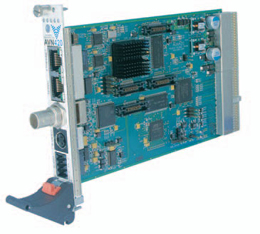Product Review: Visionary Solutions AVN420 Encoder

The Visionary Solutions AVN420 is a video encoder that certainly has an attractive price (under $3,500),
but we were curious as to whether it could produce video that was acceptable for the typical television viewer. It does. But you'll get another attractive feature - lower bandwidth use, enabled by using an MPEG-4 encoder. The AVN420 is a card that fits into one of two chassis. The first chassis a twocard MPP200. The second is the 17-slot MPP1700. With the AVN420 card, the input can be composite baseband analog or S-video.
To configure the card, use a standard browser pointed at the IP address you've assigned to the card. The input can be set with a drop down to composite or S-video. It also supports NTSC or PAL formats. You can adjust the audio characteristics to accept balanced or unbalanced audio. There is a lot of flexibility in the kind of stream that is produced as output. It's also possible to choose to broadcast audio only, video only, or both. You can also set the "group of pictures" (GOP) structure in the MPEG transport to increase the quality, if you have the bandwidth. Or, if your bandwidth budget is low, you can use a long GOP length. (For a more detailed discussion of the GOP structure in MPEG transport, read "Understanding Video Codecs" in the June 2008 issue of AV Technology). The default bit rate of 2 Mbps is probably about right for standard definition encoded as MPEG- 4. Setting it higher won't get you anything extra. Setting it too low will cause problems with the video quality.
There are also other configurations screens with important settings. You can choose to create two stream formats, transport and RTSP. You'll likely use transport when the output device is a TV, but RTSP is supported by a lot of the major video players such as QuickTime, RealPlayer, and the VLC player. While you can create a unicast to a single output device, it's more likely that you'll put each video stream on a separate IP multicast address. Nearly all popular set-top boxes (STB) support multicast addressing.
We tried some tests with the AVN420 and it performed well. Using a standard CD player as the source and setting the bit rate to about 2 Mbps, we sent a stream across a Gigabit Ethernet set of switches. An Amino STB was the target of the stream, and it decoded the video into NTSC for the TV that was attached. We used a traffic generator to introduce problematic layer two broadcast traffic to simulate occasional browsing on the IP network. The video output remained high quality and the sound was nearly perfect. Measurements of jitter were within industry specifications and about typical of other manufacturers.
University Community Hospital in Tampa, FL uses Visionary Solution encoders and a gigabit switched Ethernet network to deliver a combination of broadcast video and patient training videos to televisions and patient stations in parts of the hospital. Lynn Henrich, director, IS Technical Services for the hospital, has generally been pleased with the performance of the system and feels they saved a lot of money over a conventional head-end and system of coax cable. With a partner company, Magnet Health, developing the middleware and supplying the video on demand server, Henrich is on the frontier of video in the enterprise. He intends to expand the system to cover the other locations in his system.
The AVN420 has only a few issues worth mentioning. First, the source requires a separate encoder card. Some vendors accept two, four, or more inputs into a single encoder device. On the other hand, they are generally considerably more expensive. Also, the timing information in the video stream runs on a separate PID (program identifier), external to the video steam. While this is consistent with industry standards, it isn't common in the industry. It may mean that your test gear won't be able to find the timing values and give you accurate measurements of jitter when they are used in the field.
A daily selection of features, industry news, and analysis for tech managers. Sign up below.
- We find the Visionary Solutions AVN420 to be a real performer at an attractive price. It's easy to use and has strong, easily accessible support.
Phil Hippensteel is an industry consultant and assistant professor at Penn State University. He can be reached at pjh15@psu.edu.
The AVNetwork staff are storytellers focused on the professional audiovisual and technology industry. Their mission is to keep readers up-to-date on the latest AV/IT industry and product news, emerging trends, and inspiring installations.
